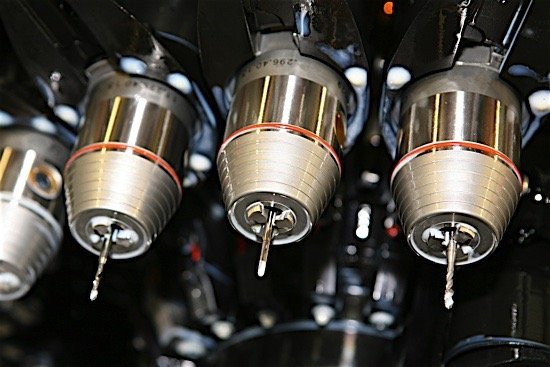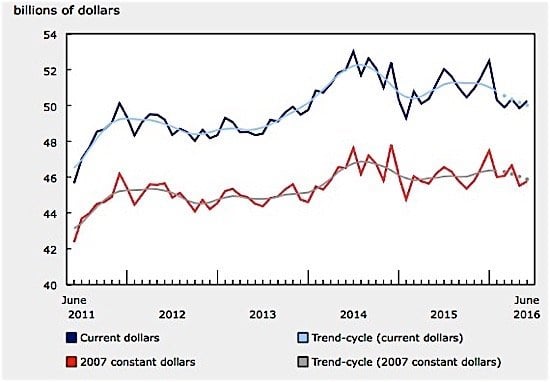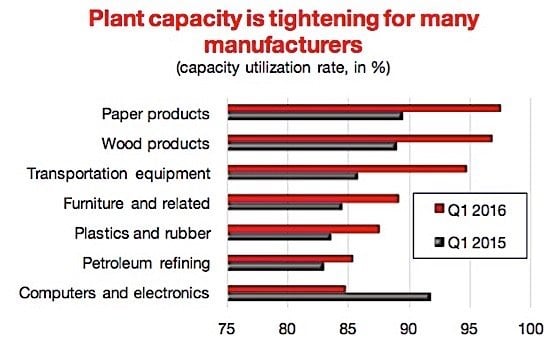
A jump in Canadian manufacturing sales in June is seen as an encouraging development for the industry, which has seen sluggish growth since hitting an all-time record last January, when $52.5 billion in sales were recorded. Sales in June reached $50.2 billion, after a disappointing 1 per cent drop the previous month. Despite being down compared to the January figure, manufacturing sales are still trending higher than one year ago, according to the Canadian Manufacturing Coalition (CMC). The increase in June was mainly due to higher sales of machinery and transportation equipment products, which accounted for three-quarters of the increase, Statistics Canada reports. Sales were up in fifteen of the twenty-one industries tracked. Sales increases might have been higher in June had it not been for the Fort McMurray wildfires of early May, which reportedly kept sales down in the machinery and fabricated metal products industries.
The rise in machinery sales came after five consecutive months of declines. Sales were up 5.8 per cent to $2.7 billion, with higher sales recorded in commercial and service machinery, agricultural, construction and mining machinery, and industrial machinery. Transportation equipment sales were up 1.4 per cent to $10.7 billion, after declining 2.5 per cent in May. Higher sales in motor vehicle parts and motor vehicle assembly industries accounted for the increase in June.
The food manufacturing industry, however, posted a decline of 1.2 per cent on lower sales of dairy and meat products.

Ontario saw the largest gain in sales, up 1.4 per cent to $24.7 billion, more than half of that due to increased sales in transportation equipment. Machinery, computer and electronic products, and miscellaneous industrial products all experienced growth ranging from 3.7 per cent to 6.4 per cent, offset only slightly by the decline in the food production industry.
Unfilled orders increased by 1.6 per cent to $90.4 billion, the third consecutive monthly increase. Statistics Canada says the increase reflected a gain in the aerospace product and parts industry, up 3.5 per cent to $51.1 billion.
Fewer manufacturers (3.2 per cent) reported in June that their business activities had been affected by the Fort McMurray wildfires of early May. Based on reports from manufacturers, the wildfire is responsible for lower than normal sales in the machinery and fabricated metal products industries in June.
In its rather somber quarterly economic update for summer, 2016, the CMC notes that manufacturing employment has been “volatile” and a “rollercoaster ride” since last fall, with 36,100 positions lost from February to May, mainly in Ontario, BC, and Alberta. Employment numbers in May were at their second-lowest in a year. Capital investment intentions are also lower in 2016, with planned spending estimated at $17 billion, down from last year’s $19.1 billion.

Future business conditions, the report says, “remain clouded” due to uncertainty over the long-term impact of Great Britain’s exit from the EU, and the shorter-term effects of the Fort McMurray fires.
Despite the decline in sales in the early part of the year (June’s increase is not included in the CMC report) manufacturing capacity utilization is reportedly higher, even “extraordinarily tight” in industries like paper and wood products (97.6 per cent and 96.9 per cent respectively) and in transportation equipment (94.8 per cent).
The CMC also reports that manufacturing productivity rose for the third straight quarter in the first quarter of 2016. While manufacturing productivity levels remain below the peak reached in summer 2014, they have improved at a faster rate than in other sectors of the economy.































